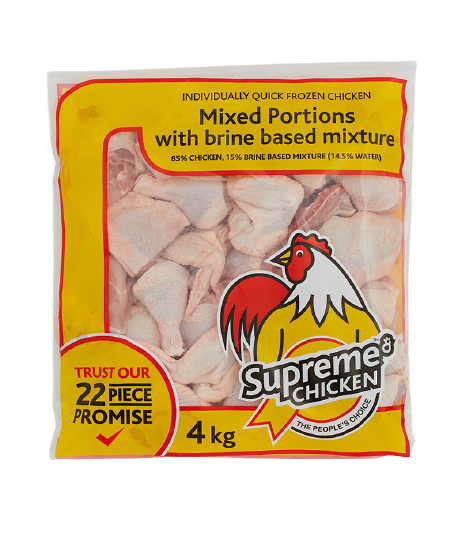Chicken Necks 10kg
R168.89
Call | WhatsApp | Email to place your Order
- 083 786 6588
- 083 786 8566
- info@enyameni.co.za
Description
1. Introduction to Butchered Chicken Necks
Welcome to our article on cooking techniques to achieve tender and juicy meat from butchered chicken necks. While chicken necks may not be the most common cut of poultry, they can be incredibly flavorful and versatile when cooked properly. Whether you’re a fan of slow-cooked stews, succulent grilled dishes, or flavorful braises, mastering the art of cooking chicken necks will elevate your culinary repertoire. In this article, we will explore various techniques and methods to ensure that your butchered chicken necks turn out tender, juicy, and bursting with flavour. So, let’s dive in and discover how to make the most of this underrated cut of meat!
1. Introduction to Butchered Chicken Necks
Why Butchered Chicken Necks?
Let’s talk about a part of the chicken that often gets overlooked – the humble chicken neck. While it may not be the most glamorous cut, chicken necks can be incredibly flavorful and make for a budget-friendly meal option. Plus, they’re packed with collagen and connective tissue, which can lead to that fall-off-the-bone tenderness we all crave. So, next time you’re at the butcher, don’t be afraid to give chicken necks a try!
The Importance of Proper Cooking Techniques
Now, cooking chicken necks is a delicate art. Without the right techniques, you might end up with tough and chewy meat that resembles a rubber band more than a delicious meal. That’s why it’s crucial to understand the proper cooking methods that will help you achieve tender and juicy chicken necks. Trust me, your taste buds will thank you!
2. Understanding the Importance of Tender and Juicy Meat
The Difference Between Tender and Tough Meat
Before we dive into the cooking techniques, let’s talk about why tender meat is such a big deal. Tender meat practically melts in your mouth, making every bite a heavenly experience. On the other hand, tough meat can feel like you’re nibbling on a leather shoe. Nobody wants that, right? By utilizing the right cooking methods, we can transform those chicken necks into a succulent delight.
The Benefits of Cooking Chicken Necks to Perfection
Cooking chicken necks to perfection not only ensures a delicious meal but also maximizes the nutritional benefits. When cooked right, chicken necks can be a great source of protein, vitamins, and minerals. Plus, the collagen-rich connective tissues can do wonders for your joints and skin. So, by achieving tender and juicy meat, you’re not just satisfying your taste buds, but also nourishing your body.
3. Preparing Butchered Chicken Necks for Cooking
Cleaning and Trimming Chicken Necks
Before you start cooking those chicken necks, it’s essential to give them a good clean. Rinse them thoroughly under cold water to remove any dirt or debris. You may also want to trim off any excess fat or skin for a leaner result. Remember, cleanliness is key when it comes to food preparation!
Seasoning and Flavoring Options
Now comes the fun part – seasoning and flavoring your chicken necks. You can go for classic options like salt, pepper, and garlic powder for a simple yet delicious taste. Or, get creative and experiment with various herbs and spices to add a burst of flavor. Don’t be afraid to let your taste buds guide you and make your chicken necks truly unique.
4. Marinating Techniques for Tenderizing Chicken Necks
The Science Behind Marination
Marinating is an excellent technique to tenderize chicken necks and infuse them with flavor. The acids, such as citrus juice or vinegar, in the marinade help break down the proteins, making the meat more tender. The longer you marinate, the more time the flavors have to penetrate the meat. It’s like giving your chicken necks a spa day!
Marinating Tips and Tricks
When it comes to marinating, there are a few tips and tricks to keep in mind. First, be sure to use a non-reactive container like glass or stainless steel for marinating. Also, don’t forget to refrigerate the chicken necks while marinating to prevent any bacterial growth. Finally, don’t overdo it with the marinade time – too long can lead to mushy meat. Aim for around 2-4 hours for optimal results.
Now that you’re armed with these cooking techniques, go forth and conquer those chicken necks! With a little practice and the right know-how, you’ll be dishing out tender and juicy meat that will impress even the most discerning taste buds. Happy cooking!
5. Slow Cooking Methods to Achieve Juicy Chicken Necks
Braising Chicken Necks
Braising is like giving your chicken necks a warm, cozy hug that results in tender and flavorful meat. To braise your chicken necks, start by searing them in a hot pan to get a nice golden brown color. Then, transfer them to a pot and add some liquid such as broth or wine. Let them simmer on low heat for a couple of hours until they become fall-off-the-bone tender. The slow cooking process allows the collagen in the meat to break down, resulting in a melt-in-your-mouth texture.
Slow Roasting Chicken Necks
Slow roasting might sound like a lazy cooking method, but it’s actually a genius technique for achieving juicy chicken necks. Preheat your oven to a low temperature, around 135°C. Season your chicken necks with your favorite spices and herbs, then place them on a baking sheet. Pop them in the oven and let them cook slowly for a couple of hours. The low heat ensures that the meat stays moist and tender, while the long cooking time enhances the flavors. You’ll end up with succulent chicken necks that are worth the wait.
6. Grilling and Roasting Techniques for Tender and Flavorful Meat
Grilling Chicken Necks
Grilling adds smoky charred goodness to your chicken necks while keeping them juicy inside. Start by marinating your chicken necks in your favorite sauce or seasoning. Preheat your grill to medium-high heat and lightly oil the grates to prevent sticking. Place your chicken necks on the grill and cook for about 5-7 minutes per side, or until the internal temperature reaches 74°C. The direct heat from the grill seals in the juices and creates a beautiful caramelized exterior that will make your taste buds dance with delight.
Roasting Chicken Necks
Roasting is a classic cooking method that works wonders for chicken necks. Preheat your oven to 200°C. Season your chicken necks with salt, pepper, and any herbs or spices you like. Place them on a baking sheet and roast for about 25-30 minutes until they are golden brown and cooked through. The heat of the oven will surround the chicken necks, sealing in the moisture and giving them a crispy skin. The result? Tender and flavorful meat that will make your dinner guests ask for your secret recipe.
7. Braising and Stewing Chicken Necks for Moist and Tender Results
Braising Chicken Necks
Yes, we’re talking about braising again because it’s just that good! To braise your chicken necks, you’ll need a combination of moist heat and time. Start by searing them in a hot pan, just enough to give them some color. Then, transfer them to a pot and add enough liquid, like broth or wine, to cover them halfway. Cover the pot and let them simmer gently on low heat for 2-3 hours until the meat becomes fork-tender. The braising liquid infuses the chicken necks with flavor, while the slow cooking ensures they stay moist and succulent.
Stewing Chicken Necks
Think of stewing as a gentle spa treatment for your chicken necks. To stew them, simply place the chicken necks in a pot along with your chosen veggies, herbs, and seasonings. Cover everything with enough liquid (broth, water, or a combination) and bring it to a simmer. Reduce the heat to low and let the chicken necks and the flavors meld together for about 1-2 hours until the meat is tender and the flavors have developed. Stewing allows the chicken necks to absorb all the deliciousness from the surrounding ingredients, resulting in incredibly moist and flavor-packed meat.
8. Tips and Tricks for Perfectly Cooked Chicken Necks
Proper Temperature and Cooking Time
Cooking chicken necks to the right temperature is crucial for achieving tender and juicy meat. Use a meat thermometer to ensure the internal temperature reaches 74°C. This is the safe temperature recommended by the USDA to kill any harmful bacteria while maintaining a juicy texture. Additionally, adjust your cooking time according to the cooking method you choose. Slow and low usually yields the best results, allowing the connective tissue to break down gradually and make the meat tender.
Resting and Serving Chicken Necks
Don’t rush to dig into your perfectly cooked chicken necks! Let them rest for a few minutes before serving. This allows the juices to redistribute throughout the meat, resulting in a more tender and juicy bite. Serve your chicken necks as a delicious main course, or use them as a flavorful addition to soups, stews, or salads. Get creative and give your taste buds a delightful treat!
8. Tips and Tricks for Perfectly Cooked Chicken Necks
In conclusion, mastering the cooking techniques for tender and juicy meat from butchered chicken necks can open up a world of delicious possibilities in your kitchen. By properly preparing, marinating, and cooking these often overlooked cuts, you can transform them into delectable dishes that will leave your taste buds wanting more. Remember to experiment with different seasonings, cooking methods, and flavors to find your personal favorite. With the tips and tricks shared in this article, you are now equipped to create mouthwatering meals that showcase the potential of butchered chicken necks. So, why not give it a try and surprise your family and friends with a tantalizing chicken neck dish at your next gathering? Happy cooking!
FAQ
1. Can I use chicken necks from a whole chicken for these cooking techniques?
Yes, you can use chicken necks from a whole chicken for these cooking techniques. However, keep in mind that the cooking times and methods may vary slightly depending on the size and thickness of the necks. Adjust the cooking time accordingly and ensure that the chicken necks reach a safe internal temperature before consuming.
2. Are there any alternative cuts I can use if I can’t find chicken necks?
If you are unable to find chicken necks, there are a few alternative cuts that can be used to achieve similar results. Chicken drumsticks, thighs, or even bone-in chicken breasts can be substituted for chicken necks in some recipes. However, the texture and cooking times may vary, so it’s important to adjust the techniques accordingly.
3. How long should I marinate chicken necks for the best results?
The ideal marinating time for chicken necks can vary depending on the recipe and desired flavor intensity. In general, marinating for at least 1-2 hours is recommended to allow the flavors to penetrate the meat. For a more intense flavor, marinating overnight or up to 24 hours can produce even better results. However, be cautious not to marinate for too long, as acidic ingredients can break down the meat and affect the texture.
4. Can I use these cooking techniques for other cuts of chicken?
While the focus of this article is on cooking techniques for butchered chicken necks, many of these methods can be applied to other cuts of chicken as well. The principles of marinating, slow cooking, grilling, roasting, braising, and stewing can be adapted for various cuts to achieve tender and juicy results. Feel free to experiment and adapt these techniques to suit your preferred chicken cuts.





